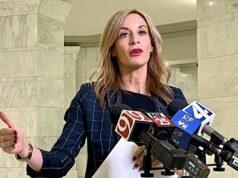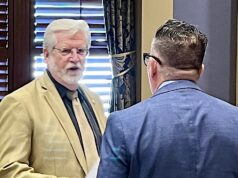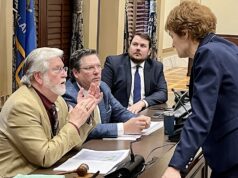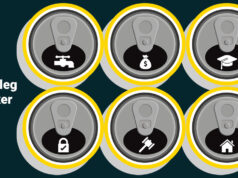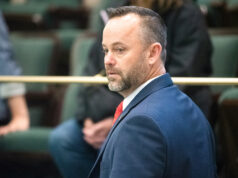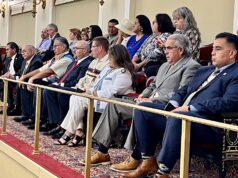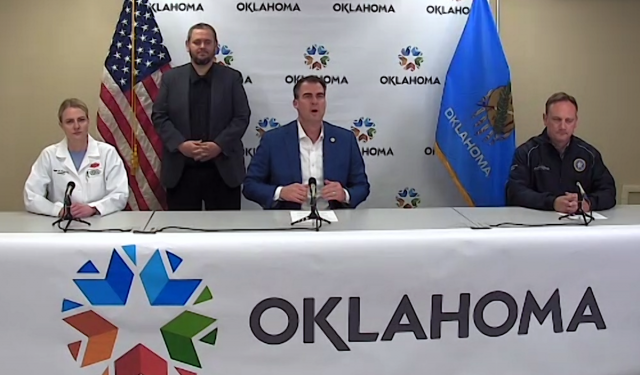
Oklahoma Gov. Kevin Stitt announced the latest version of his COVID-19 executive order this afternoon, expanding business restrictions statewide and extending his “safer at home” requirements for seniors and those with compromised immune systems through April 30.
But pressed by media to explain why he is not ordering all Oklahoma residents to “shelter in place” through the month of April, the first-term governor said doing so would be unworkable.
“It’s unpractical for us to do a ‘bunker in place’ for the next 30 days because not everybody can get their food delivered,” Stitt said. “We have to get out and do some things.”
One of the things Stitt wants done is a major expansion in COVID-19 testing, something he, Secretary of Mental Health Jerome Loughridge and Secretary of Science and Innovation Dr. Kayse Shrum have promised in past press conferences.
“We are lifting some of the restrictions we had on who can be tested,” Stitt said, adding that Oklahoma now has 13,600 test kits available. “OSU has opened up its lab and can do 2,300 tests per day now. (…) Anyone with symptoms of COVID-19 or anyone who has come into contact with someone who has COVID needs to be tested this week.”
Stitt emphasized key symptoms of the novel coronavirus as a fever higher than 100.4, coughing and shortness of breath.
“By the end of this week, we should have 13 mobile testing facilities throughout the state,” Stitt said, noting Altus, Woodward and Lawton as specific communities with mobile testing. “I want to stress that our state can process these tests in-state now. Do not turn people away (from hospitals or medical offices) that are showing symptoms of COVID-19.”
Low Oklahoma COVID-19 testing rate lacks key data
As national and local attention on Oklahoma’s rate of COVID-19 testing per capita intensifies, one factor driving the low rate has been the reliance on private laboratories to process tests. To this point, those laboratories have only reported positive test results back to the Oklahoma State Department of Health, which notes the statistical limitation on its coronavirus website with an asterisk.
“Negative testing results are only from the State Public Health Laboratory and do not include private laboratory negative results,” the asterisk explains.
Tuesday, Commissioner of Health Gary Cox sent a letter (embedded below) to private laboratories asking them to comply with state statute and report both positive and negative test results so those modeling Oklahoma’s outbreak have more data points. Asked about the private companies’ communication of negative test results, Loughridge said this afternoon that “we need to get the denominator of our math up.”
“The letter (…) is designed specifically to do that, to require the reporting of our negatives. If not, we only have part of the equation,” Loughridge said.
Shrum agreed.
“It is important for us to understand both the positives and the negatives, and it has been more challenging to get the negative results back,” Shrum said.
Oklahoma’s incomplete data has been scrutinized by national media over the past week, but not for being incomplete. Instead, Vox’s presentation of available data simply shows Oklahoma with one of the lowest per-capita testing rates in the country. Likewise, Politico published an article this morning warning that states like Oklahoma with low testing rates contain “emerging hotspots.”
But the true rate of Oklahoma’s COVID-19 testing is unknown without considering the number of negative tests completed by private laboratories. Questions asking Stitt, the secretaries and the Department of Health to estimate the number of negative tests processed by private laboratories have gone unanswered, but the breakdown of positive results offers some perspective.
Of 719 positive Oklahoma cases, 150 have been confirmed by the State Department of Health’s lab while 569 have been confirmed by DLO or “other” laboratories. That means nearly 80 percent of Oklahoma’s positive COVID-19 results so far have come from labs other than the State Public Health Laboratory.
Just under 11 percent of the tests completed by the State Public Health Laboratory have come back positive. If other labs were also seeing an 11 percent positive rate, that would mean they have completed about 4,604 negative tests.
But until the State Department of Health actually obtains and reports that information from other laboratories, those figures offer only crude estimates and are not being factored into national or state-by-state comparative data.
“As we’ve talked a lot about modeling and the data, the tests are the data that help us see into the future,” Shrum said. “So testing more people is important (as is) understanding whether that’s positive or negative.”
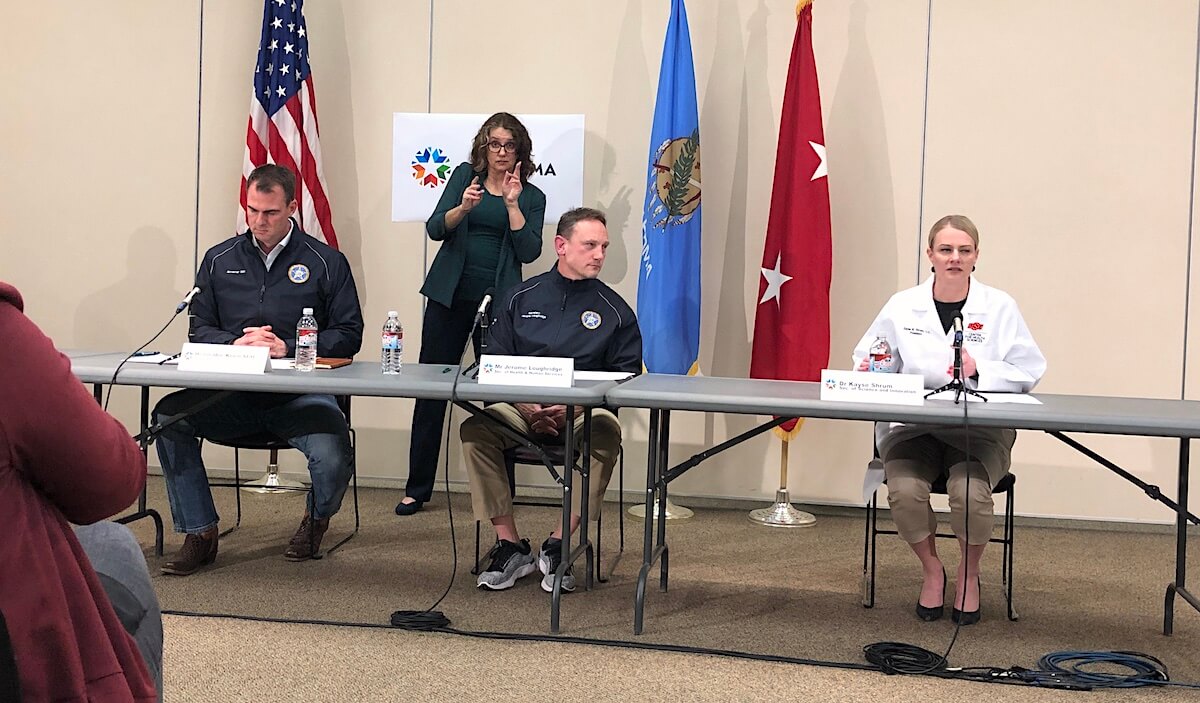
‘We are not testing enough people’
Oklahoma’s lack of true numbers has fueled public frustration, and members of the state House of Representatives have also become critics of the testing situation.
House Majority Leader Jon Echols (R-OKC) offered “personal commentary” about Oklahoma’s COVID-19 testing in his Facebook post Tuesday.
“We are not testing enough people. There is no reason for our death rate to be so high as compared to other states and even most nations at this stage of the pandemic. That tells me there are not enough people being tested,” Echols wrote. “This is a situation that must be rectified. I do know that many in the state are working extremely hard to get this situation fixed. Additionally, I have been trying to help two private labs get the federal and state approval they need to start testing more [Oklahomans]. Testing helps us make decisions based upon accurate information. The current situation is simply not acceptable.”
Stitt seemed to agree Wednesday afternoon, calling for a ramp-up of COVID-19 testing two weeks after he and health officials reined in testing guidelines amid an international reagent shortage. Preceded by a shortage of testing kits, the reagent issue has also affected private laboratories, at which “testing backlogs have ballooned” across the country, according to The Atlantic.
Stitt said he hopes to release data modeling on COVID-19 in Oklahoma by the end of this week.
“One of the things that will help the modeling as we try to model these peaks is more testing,” Stitt said. “The best way to slow the curve and stop the spread of COVID is more testing and more tracing, as well as continuing to practice social distancing.”
Prior to Stitt’s updated executive order today, only the 48 counties with a diagnosed case of COVID-19 were under limitations or closures of “non-essential” businesses. Now, all 77 counties must have restaurants transition to carryout-only service, and businesses like theaters, barbershops, salons and tattoo parlors must close.
Stitt also said Wednesday that he expects a final report from the U.S. Army Corps of Engineers on options for the creation of emergency COVID-19 hospitals inside arenas or other large structures in the Oklahoma City and Tulsa areas. Additionally, he and Loughridge reiterated a proposal that would identify individual existing hospitals in those metro areas that would be designated for the treatment of COVID-19 patients.
Gary Cox letter to private laboratories on COVID-19 testing
 Loading...
Loading...
(Update: This article was updated at 5:45 p.m. Wednesday, April 1, to include additional information. It was updated at 4:45 p.m. Saturday, April 4, to correct Loughridge’s title.)










